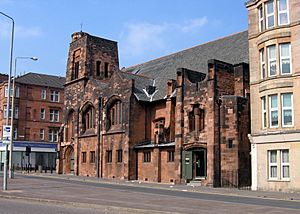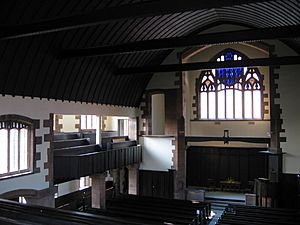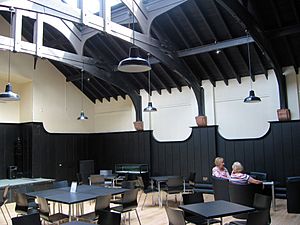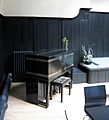Queen's Cross Church, Glasgow facts for kids
Quick facts for kids Queen's Cross Church |
|
|---|---|
| The Mackintosh Church | |
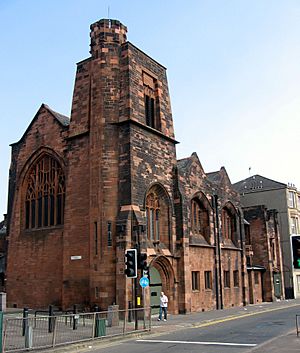
The church tower seen from the road junction
|
|
| 55°52′49″N 4°16′18″W / 55.880286°N 4.271632°W | |
| Location | Glasgow |
| Country | Scotland |
| Denomination | Secularised |
| Previous denomination | Church of Scotland |
| Website | Website |
| Architecture | |
| Functional status | Museum & Venue hall |
| Architect(s) | Charles Rennie Mackintosh |
| Architectural type | Church |
| Style | Art Nouveau |
| Groundbreaking | 23 June 1898 |
| Completed | 10 September 1899 |
| Specifications | |
| Materials | Red Sandstone Ashlar |
Queen's Cross Church is a special building in Glasgow, Scotland. It used to be a church, but now it's a museum! It's super famous because it's the ONLY church ever built that was designed by a brilliant Scottish artist and architect named Charles Rennie Mackintosh. That's why people also call it The Mackintosh Church.
Contents
History of the Church
In 1896, a group called the Free Church of St Matthew wanted a new church. They asked a well-known architecture company, Honeyman and Keppie, to design it. The church was planned for an area in Glasgow called Springbank, near Maryhill.
John Honeyman, one of the main architects, gave the job to a young, very talented trainee named Charles Rennie Mackintosh. The spot chosen for the church was a bit tricky. It was on a corner, surrounded by other buildings. The Free Church wanted a simple design, which fit Mackintosh's style.
Building work started, and a special stone was laid on June 23, 1898. The church was finished quickly, and its first service was held on September 10, 1899.
Mackintosh also designed a big cathedral for Liverpool in a competition, but it was never built. So, Queen's Cross Church is the only church he ever saw completed. He started working on it soon after finishing his design for the famous Glasgow School of Art.
Mackintosh's Unique Design
Charles Rennie Mackintosh was known for his unique style. He mixed different ideas to create something new.
Outside the Church
Unlike many churches in Glasgow, Queen's Cross Church doesn't have a tall, pointy spire. It looks more solid and strong, almost like an old castle. Some architects called its style 'Modern Gothic'. Mackintosh got ideas for the main tower from a church he saw in Merriot, England, back in 1895.
Inside the Church
The stained glass windows in Queen's Cross Church are not super flashy like in some huge cathedrals. But they have a very clear Mackintosh style. You can still see this style in many souvenirs and designs today.
The roof inside is amazing! It's shaped like a half-circle, called a barrel-vault, and is made of wood. It stretches all the way across the main part of the church, which is about 40 feet wide.
The pulpit, where the speaker stands, has special carvings. These designs repeat five times around its curved front. Some people think they look like a bird's wings protecting young plants.
You can see old-fashioned 'Gothic' ideas in the design, like the stunning blue-heart stained glass window. There are also parts that look like they came from before the Reformation, such as a copy of the original rood beam. This beam is very special and unique in Scotland. You might even spot some Japanese influences in the double beams and hanging decorations inside the church!
Home of the Charles Rennie Mackintosh Society
In the 1970s, Queen's Cross Church stopped being used for regular services. Many old churches are turned into theaters or apartments, or even torn down. But because Charles Rennie Mackintosh's work is so popular, this church was saved!
Now, it's the home of the Charles Rennie Mackintosh Society. This group owns and runs the church as a place for visitors. It's a great spot for tourists to learn about Mackintosh and his amazing designs.
The building next door, which used to be the church hall, now has a tearoom. There's also a display area under the balcony. Here, you can see cool items, including copies of the chairs Mackintosh designed for the famous Willow Tearooms.
Images for kids


